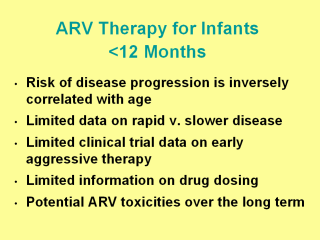| front |1 |2 |3 |4 |5 |6 |7 |8 |9 |10 |11 |12 |13 |14 |15 |16 |17 |18 |19 |20 |21 |22 |23 |24 |25 |26 |27 |28 |29 |review |
 |
The risk of disease progression is inversely
correlated with the age of the child, with the youngest children at greatest
risk for rapid disease progression. In early reports, approximately 20–25%
of HIV-infected children progressed to AIDS or death within the first year
of life; in more recent reports, with follow-up through 1999, high rates of
progression continue to be observed in young infants, with development of
AIDS or death in 15% of HIV-infected children by age 12 months [ECS01].
Progression to moderate or severe immune suppression is also frequent in
infected infants; by 12 months of age, approximately 50% of children develop
moderate immune suppression, and 20% severe immune suppression [77]. Although the risk of progression is greatest in the first year of life, the ability to differentiate children at risk for rapid versus slower disease progression by clinical and laboratory parameters is most limited in young infants. Plasma HIV RNA levels are much higher in HIV-infected infants than older infected children and adults, and the predictive value of specific HIV RNA levels for disease progression are more difficult to interpret in infants <12 months old [27,51]. Identification of HIV infection during the first few months of life permits clinicians to initiate ARV therapy or intensify ongoing therapy used for chemoprophylaxis of perinatal transmission during the initial phases of primary infection. However, only limited data address the efficacy of aggressive therapy for HIV-infected infants. Potential problems exist with universal therapy for infants. Definitive clinical trial data documenting therapeutic benefit from this approach are not currently available. Studies in both adults and children suggest that optimal benefit is achieved with the first antiretroviral treatment regimen, but information on drug dosing in infants under age 3–6 months is limited. Hepatic and renal functions are immature in the newborn that can result in substantial differences in ARV dose requirements between infants and older children. |